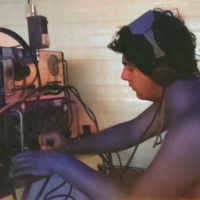SmartSDR v4.1.3 and the SmartSDR v4.1.3 Release Notes
SmartSDR v3.10.15 and the SmartSDR v3.10.15 Release Notes
The latest 4O3A Genius Product Software and Firmware
Need technical support from FlexRadio? It's as simple as Creating a HelpDesk ticket.
New 'remote CW' program
The usual problems are
a) The sidetone isn’t available on the same audio channel as the Flex or
b) The CW is interpreted locally, and ASCII characters are sent to the radio side for transmission. The problem with this is that hand-sent CW needs to be perfect, otherwise the sent CW won’t replicate what is actually keyed. It sends what ‘it thinks’ was keyed.
I’ve recently come across a Windows program that get’s over both these issues, and since it has a client/server architecture will support multiple users.
Remote CW Keyer by DL4YHF measures the actual key-down and key-down timings; it then sends the time information to the radio-side to recreate the characters for transmission. Hence, whatever is keyed, is sent.
The link is here: https://www.qsl.net/dl4yhf/Remote_CW_Keyer/Remote_CW_Keyer.htm
I’ve been using it for a couple of weeks now, including the All Asia contest. The program runs in ‘client’ mode on my PC at home, along with SSDR; side-tone is output on the same sound device as the Flex.
The key (straight or paddle) plugs into the control-side serial port (FTDI USB adapter is OK) via a small circuit – it’s easy to build and encapsulate the components in the 9-way serial plug. At the radio side, a Windows PC runs the DL4YHF program in ‘server’ mode and there is a cable from the PC’s serial port (or FTDI USB ) to the Flex CW socket; again, with a small circuit built into the serial port connector.
All the information is on the author’s website. I have no connection, just a happy user.
I’ve gone one step further by integrating the above solution with a control-side Winkey unit. My logging program connects to the physical WK unit and the iambic key plugs into it. The output from the Winkey unit is input to the serial port on my control-side PC as a ‘straight key’ for DL4YHF’s program to handle the remote connection. The Flex SSDR sidetone is switched off so I listen to the DL4YHF sidetone – both the contest macros and my keyer are there, it works great. Yes I could use the SSDR Winkey emulator but the experience with a physical WK unit is much improved.
I’ve documented my solution here:
https://www.g4irn.com/home/articles-information/remote-station-cw-operation
73 John G4IRN
Comments
-
John! Thanks for the posting. I have sent you en email about this today.
0 -
Thanks for posting John. We are seeing more and more solutions that send actually CW timing data to the radio just like the Maestro does.
0 -
Thanks for posting. Interesting system. Question: This solution appears to be [overly] complex with need for PC server computer on site to run special software and COM port connections on both radio server and client side and so forth. I have been using a different and very simple CW solution with SmartSDR for the Mac and just a simple HaliKey interface connection from my paddle (or straight key) and usb-c port on MacBook. That's it. Side tone is realtime at the remote MacBook client, SmartSDR for Mac has the WinKey software builtin and everything works as expected. Perfect. You can operate in CW as by straight key, paddle or using the CWX keyboard method and view of CW sent and optionally also use the CW decoder for CW received or not, if that's your thing - I decode in my head. So… Everything is built into the Mac client and no need for a Windows PC running special software on radio server side. Just one simple connection to paddle via usb-c on client side. Nothing extra needed on radio server side. The Question is why is there a need for DL4YHF’s solution for Mac users? What is the Value add? There must be something, but I am not seeing it (yet). I am sure there must be significant value given the extra complexity or not. Or maybe this is just for Windows and / or legacy configurations? Thanks for info in advance, Dan de WA1QZX.
0 -
An old June post from John. My vote is for MORCONI, but it's mostly DIY currently. No need for a computer or a Winkeyer anymore. MORCONI directly, accurately, and remotely keys all Flex Radios from a hand key or paddle. It does not interfere with CWX functionality.
It is built around a low cost Teensy 4.1 SBC. It uses the same "time stamped" packet signaling that is used by the Maestro so like the Maestro, it directly keys the radio via Ethernet/Internet without further interfaces. There are options for keying all other radios too. It has many popular keyer style functions, adds 3rd party logging/contest SW keyer interface functions like the Winkeyer does, has local sidetone, and is not limited to Apple users. I suspect John has moved on too.
Check out the MORCONI on groups.io. I have no commercial interest in MORCONI other than being a satisfied user.
Here's my latest iteration of MORCONI innards (courtesy of KC9JOB) that will mount in nearly any project box without the need to print one or "drill" square connector holes:
73, Fred
K9SO
0 -
MORCONI is also available directly from me as a fully assembled and tested unit.
1 -
Does it work with SmartSDR for Mac?
0 -
Dan, Yes.
SInce it interfaces with the radio directly via the Flex API ports, it should be independent of the SmartSDR version.
Fred
K9SO
1 -
Fred, Thank You, I only operate over remote WAN from MacOS client. Dan WA1QZX
0 -
Hi Dan,
MORCONI is a standalone system, independent from the computer, its OS, and the SmartSDR version.
Just needs a network connection to the radio.
73, Max
1 -
Oh! Thanks Max.
0 -
I have previously made a remote CW device, which consists of a transmitter and a receiver. It works well when using a wired network, but when using a wireless network, it may not function properly due to the uncertainty of network transmission delay. I am very interested in MORCONI. Can anyone tell me about its detailed implementation method0
-
MORCONI works fine also on Wireless Networks:
0
Leave a Comment
Categories
- All Categories
- 372 Community Topics
- 2.1K New Ideas
- 629 The Flea Market
- 8.2K Software
- 94 SmartSDR+
- 6.4K SmartSDR for Windows
- 183 SmartSDR for Maestro and M models
- 424 SmartSDR for Mac
- 270 SmartSDR for iOS
- 255 SmartSDR CAT
- 190 DAX
- 381 SmartSDR API
- 9.3K Radios and Accessories
- 36 Aurora
- 249 FLEX-8000 Signature Series
- 7.2K FLEX-6000 Signature Series
- 937 Maestro
- 54 FlexControl
- 863 FLEX Series (Legacy) Radios
- 917 Genius Products
- 460 Power Genius XL Amplifier
- 334 Tuner Genius XL
- 123 Antenna Genius
- 294 Shack Infrastructure
- 206 Networking
- 452 Remote Operation (SmartLink)
- 144 Contesting
- 782 Peripherals & Station Integration
- 139 Amateur Radio Interests
- 997 Third-Party Software




